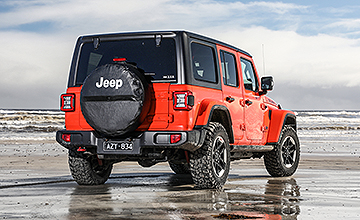
Overview
SINCE 1941 there have been five Wranglers – the WW2 MB original courtesy of Willys, and four CJ (Civilian Jeeps) from 1945 to 2018.
Now there’s the sixth-generation JL, promising huge strides in safety, refinement, comfort and on-road driveability to go with its go-anywhere off-road dominance.
Frustratingly, only the bush-bashing Rubicon version was available for our first taster, but even off the beaten track, it is clear the iconic 4x4 has come a long way since the last big remake of 2007.
Drive impressions
During the latest Wrangler’s press conference, one of Jeep’s senior presenters (a two-decade company veteran) whimsically described it as the 4x4 world’s Porsche 911.
Ignoring the irony of that statement – Willys started building the original General Purpose (GP – or ‘Jeep’) vehicle in 1941 as a tool against Germany’s war machine, after all – it helps to keep the American icon’s place in the world in mind when contemplating the all-new and sixth-generation iteration.
There’s nothing quite like a Jeep and that’s how its legions of fans around the world want it to stay. To do otherwise would be akin to changing Coca Cola’s recipe to appease the anti-sugar lobby. Corporate madness.
So here we are in the top-line Rubicon, named after the infamous off-road trail that few 4x4s of any description can conquer unmodified, and the choice of Wrangler if bush-bashing is your bag. Speaking of choice, we had none – it was this or go home. The base Sport S, luxury Overland and all two-door wagons weren’t as-yet ready for the launch. Never mind.
The first thing that strikes us is how handsomely detailed and well-proportioned this longer-wheelbase, four-door, five-seater wagon version is, particularly with its chunky off-road wheels and tyres and especially in the vibrant colours available. As the timeless 500 proves, Fiat Chrysler Automobiles knows a thing or two about retro.
Inside, the story is even better, given how cruddy and dated the previous-gen (JK) Wrangler was. Gone is the old dash with its cheap plastics and sheeny finishes, for a far-more contemporary re-interpretation of what a Jeep cabin should look like – modern, simple practicality, but with an emphasis on rugged detail design.
Standout items include clear, comprehensive instrumentation, easy multimedia functionality and unfettered access to most switchgear, which now runs to auxiliary plugs for accessories and other 4x4 whatnots. It all works as intended.
On the flipside, given the $10,000 price rises across the board, we expected a few more standard niceties inside, such as height adjustment for the front passenger seat. And the driver’s left foot has nowhere to go due to the wide transmission tunnel that eats into the pedal space. Is this a right-hand-drive-only malady?
The thing is, we only really drove the Rubicon briefly on rural Tasmanian highway roads, on massive off-road tyres, so it was difficult to ascertain the level of improved seat comfort, noise suppression and refinement gains that Jeep claims beyond the higher-quality interior, hushed powertrain and quite punchy performance from both powertrains on offer (147kW/450Nm 2.2-litre four-pot turbo-diesel and carryover 209kW/347Nm 3.6-litre naturally-aspirated V6 petrol – both driving all four wheels via a box-fresh ZF eight-speed torque-converter automatic).
Compared to practically every other vehicle, the Rubicon is still quite loud in terms of road and tyre noise, and ponderous on bitumen at speed due to its quite remote steering and a total lack of feel and feedback from the front end. It still feels quite like a focused 4x4 truck.
That said, all we can confirm is that the latest iteration does seem a damn-sight better than its predecessor in practically every aspect. And, more importantly, off the beaten track, a better companion would be difficult to imagine.
As the pictures reveal, the toughest Wrangler is equipped to climb steep and rocky trails, ford deep and fast-flowing rivers without stranding its dry occupants, and clamber down super-muddy and slippery tracks like it was born to do so. And does so with superb insouciance.
The anti-roll bars can now be electronically detached to aid the already impressive wheel articulation in seconds, while there’s enough low-ratio grunt to power through tricky terrain.
All the necessary levers and buttons are right there in front of the driver, with real-time data and pictures on the screen, to help the Rubicon get there and back again.
Special kudos should go to how absorbent, smooth and controlled the ride is in much of these challenging conditions.
Where the new JL really shines is just how actually convertible the now-partly aluminium body is; the T-top panels can be removed (and reattached again) quickly and are light enough to be stowed just as easily, to open up the great outdoors.
There’s also the rear roof section that does require at least a couple more people to help unscrew the panels out, for true cabriolet travel through the wilds.
And the hose-out interior feels robust enough to take all the mud, sand and grime that such adventuring entails.
Just as you’d expect from a Wrangler, which brings us back to the start. Jeep hasn’t dumbed-down or compromised the very thing that every previous generation version has been able to do since the 1940s, it’s just that the 2020s version adds comfort, refinement, safety, connectivity and civility to the same old recipe. This means that the JL broadens its scope and appeal in ways we’d never have expected a decade ago.
The real test will come when we get our hands on the not-so-off-road-focused Sport S and Overland, to see if their dynamics and driveability leap forward as far as Jeep has us hoping on everyday urban roads.
Until then, though, rest assured that the Porsche 911 of 4x4s still does exactly what it says on the tin.